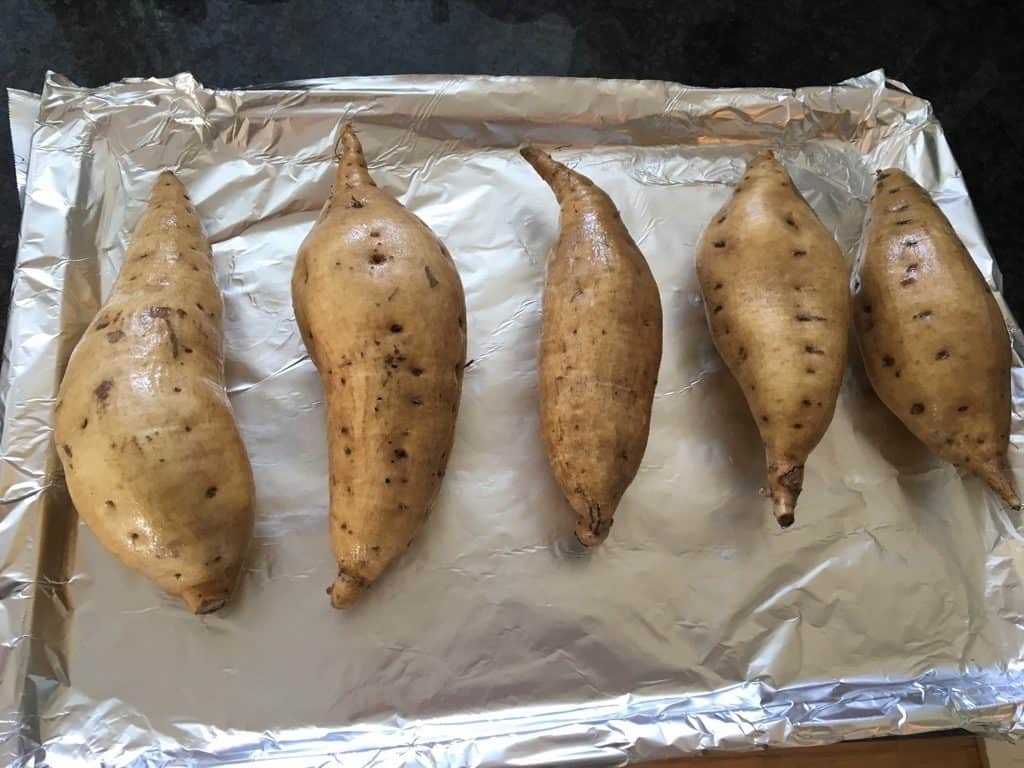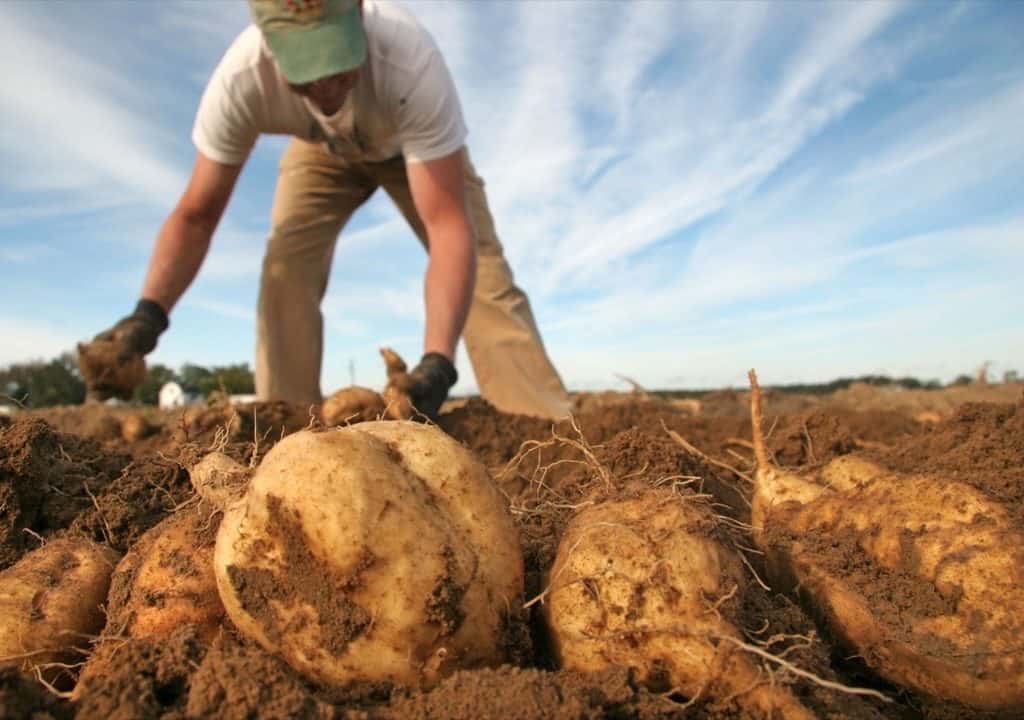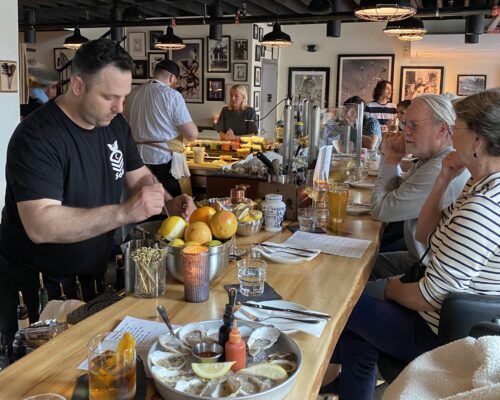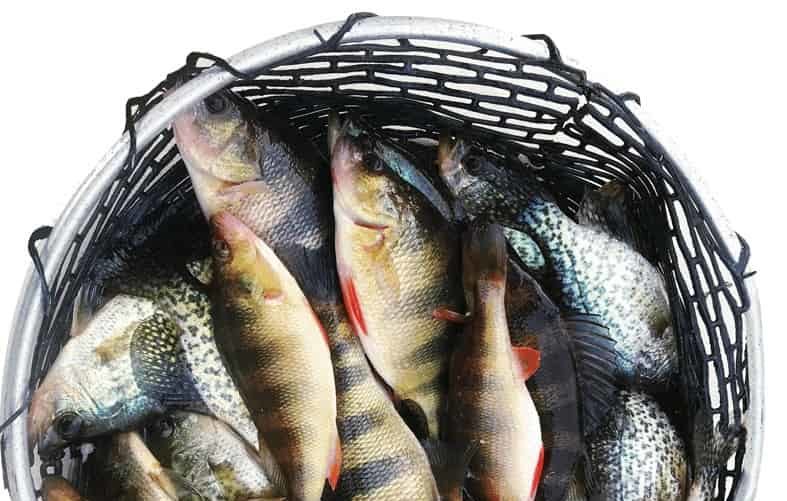Virginia’s Eastern Shore farmers and foodies nurture a fragile sweet potato
In the weeks before Thanksgiving, cooks up and down the Eastern Shore of Virginia begin their annual scavenger hunt to secure a prized staple of the turkey-day dinner, the elusive Hayman sweet potato.
Haymans are a white-skinned, light-green-fleshed, and sparsely-cultivated variety that is often avoided by farmers due to low yields and by consumers for their gnarly shapes. Yet Haymans are prized by Eastern Shore epicures despite being largely unknown beyond the Delmarva peninsula, southeastern Virginia, and northeastern North Carolina.
Where to get them
Baines’ Farm Stand— Southeast corner of Bell Lane and Route 13, Machipongo. Haymans grown in the field next to the stand are available starting in late October or early November.
Marilyn’s Fruit & Vegetable Stand—Northwest corner of Route 13 and Occohannock Neck Road, Exmore. Open seasonally 8 a.m. to 5 p.m.
No phone.
Pickett’s Harbor Farms—3119 Pickett’s Harbor Drive, Cape Charles, 757-331-2682. pickettsharbor.farm and Facebook. Available in early November until they are sold out.
Quail Cove Farms—12435 Machipongo Lane, Machipongo. 757-678-7783. qualicovefarms.com. Available in mid-November and sell out quickly.
Pungo Creek Mills—757-442-6327, pungocreekmills@verizon.net produces the heirloom cornmeal called for in Amy Brandt’s spoonbread recipe (see below). Bill and Laurel Savage produce meal from multi-hued Indian corn that has been grown on the Eastern Shore of Virginia for over 165 years.
The cornmeal has an unusual texture, color and flavor and is well worth seeking out.
So sweet that they drip sticky black sap from their ends, the Hayman’s pale, sage-colored flesh tastes naturally like honey with a pinch of cardamom when baked. Doused with gravy, mashed into pies or folded into biscuits, Haymans have achieved iconic status among many in the know.
“When you bake that Hayman potato, that is one of the best potatoes you are ever going to sink your teeth in. They are delicious baked, fried, slide-to-the-side, however you want to do them— they are good!,” says Tonja King, longtime employee at Marilyn’s Fruit and Vegetable Stand in Exmore, Virginia. “In the fall,” she adds, “People flock here to get Haymans. They go like hotcakes.”
As the story goes, Haymans first came to southeastern Virginia in the mid-1850s when Captain Daniel Hayman docked his ship in Elizabeth City, North Carolina. A visiting Methodist minister noticed an unusual-looking sweet potato the captain had picked up as cargo in a Caribbean port and acquired some for propagation.
The eponymous Hayman sweet potato spread across the Delmarva alongside the sermons of Methodist missionaries, exchanged at tent revivals and carried on their ecclesiastical sailing skiffs as they visited isolated churches far up Eastern Shore creeks. In their quest to save souls, the preachers also converted Eastern Shore taste buds to the heavenly Hayman sweet potato glory.
The Hayman was initially hailed as highly productive and a good winter keeper. By the turn of the 20th century, the Hayman was a ubiquitous commercial cultivar on the Eastern Shore and shipped by train and boat to markets in New York, Baltimore and Philadelphia. But other cultivars have long eclipsed the Hayman in these desirable traits leaving the Hayman with little but its knockout taste.
The Hayman’s parsimonious yield of marketable tubers (sweet potatoes are technically root tubers) is perhaps the principal reason it has not thrived commercially. A 2018 study by Virginia Tech found that Haymans trailed the sweet potato pack in terms of productivity. The study concluded that, “Many local consumers prefer the white variety Hayman, but alternative white-flesh varieties with better yield and storage root quality are available for commercial production.” The clear message to farmers, “Don’t grow Haymans.”
The Hayman’s rarity, historical significance and unique flavor was recognized when it was elected to Slow Food USA’s Ark of Taste, a “living catalog of delicious and distinctive foods facing extinction.” Slow Food USA says of the Hayman, “In the 21st century it has become the signature sweet potato of the Virginia Eastern Shore. Greatly prized locally . . . the Hayman is a varietal that remains limited in its circulation. Current production is limited to a small group of growers who share seed stock and cultivation practices.”
This handful of dedicated planters keep the tradition of the Hayman sweet potatoes alive, mainly for an appreciative local audience. In Northampton County, the heart of the Hayman’s traditional range, the bulk of the Haymans are grown by just three men: Bill Jardine (and his son, Billy) and William Baines, both in the tiny hamlet of Machipongo, and W.T. Nottingham in the southern reaches of the county.
Baines grows Haymans to sell at his Machipongo farmstand on Route 13. His nephew, James Braxton, says, “Once word is out we have Haymans, they flock here. No one ever asks about red sweet potatoes. But if we planted every acre we have in Haymans we could sell them all here on the Shore. Haymans are sweeter, almost syrupy, and make a better pie. You don’t even need to add spice.”
Nottingham says “Haymans are a tradition that is fading,” not because people have lost their taste for Haymans, but because fewer and fewer growers make the effort to cultivate the unpredictable and largely unprofitable tuber. “Some years the yield is good and some not, and there is no predictability. Grand sum total, you might have ten acres of Haymans growing on [Virginia’s] Eastern Shore that I am aware of,” he estimates. Despite all that, he says, “We sell out in two weeks every fall.”
Virginia farmers reported growing just 136 acres of sweet potatoes in 2012, down from a high of 19,000 acres in the 1960s. Nevertheless, the Eastern Shore’s gustatory passion for Haymans has remained enflamed for over
160 years.
Bill Jardine—a Delaware native who moved to the Eastern Shore more than 40 years ago—and his son, Billy, cultivate about five acres of Haymans for sale in their Quail Cove Farms store. “No matter how hard you chase the Hayman, no one is going to make a living off it. You have to grow it out of the love of the Hayman,” he says. Why do people go out of their way to get Haymans for Thanksgiving? “People want something that is real. Haymans are rich in tradition. They are not real common, and they are a way to explore a new taste,” he adds.
Hayman sweet potatoes are not just for Thanksgiving. Although commonly eaten baked or utilized as prime pie timber, Haymans are versatile and add their spicy, honey flavor to any recipe that calls for sweet potato or squash or as a unique substitution for Irish potatoes.
Chef Amy Brandt reflects, “There is nothing like a Hayman. They are one of the super-special ingredients we have here, and that is something I like to honor in my cooking.” “Haymans stand by themselves. There is a beauty in a small, well-cooked Hayman sweet potato. Cook them slowly and be sure to eat the skin,” she says.
If you can get them. The supply is scooped up in a few weeks, but those lucky enough to obtain the real thing will savor a sweet slice of Eastern Shore culinary history and tradition second to none.
The Classic Eastern Shore Hayman Baking Method
- Heat oven to 350 degrees
- Wash Hayman sweet potatoes well and dry. Do not pierce them with a fork!
- Rub all over with cooking oil or Crisco.
- Bake on a cookie sheet for an hour or until a knife easily slides into them.
- Remove from oven and cover with a dampened kitchen towel for at least a half-hour as they cool. They are ready to be eaten as-is or used in other recipes.

Amy Brandt’s Hayman Spoonbread
Ingredients
1 cup baked Hayman sweet potato pulp
2 1/4 cups Pungo Mills Creek Mills
cornmeal* or commercial stone-ground cornmeal
2 tsp kosher salt
1 1/2 tsp baking soda
1 1/2 tsp baking powder
2 oz butter
3 cups water
1 1/2 cups cream
4 Tbsp maple syrup
¼ tsp nutmeg
1/8 tsp cayenne pepper
5 eggs—separated
Preparation
- Preheat oven to 375 degrees
- Butter a casserole dish with softened butter. Coat the butter with bread crumbs and knock out the excess.
- In a medium bowl, combine the cornmeal, salt, baking soda and baking powder. Set aside.
- Combine the cream, Hayman sweet potato, maple syrup, nutmeg and cayenne. Set aside.
- Bring to a boil the water with the butter. Remove from heat and rain in the cornmeal mixture. Whisk to combine completely.
- Whisk the cream mixture into cornmeal mixture a bit at a time until all is incorporated. Whisk a very small amount of the warm cornmeal mixture into the egg yolks adding three more small amounts. Add the yolk mixture into the cornmeal mixture, combining completely.
- Whisk the egg whites until stiff. Gently fold into cornmeal mixture
- Transfer the mixture to the prepared casserole. Place in oven and bake for 45 minutes or until just set.




